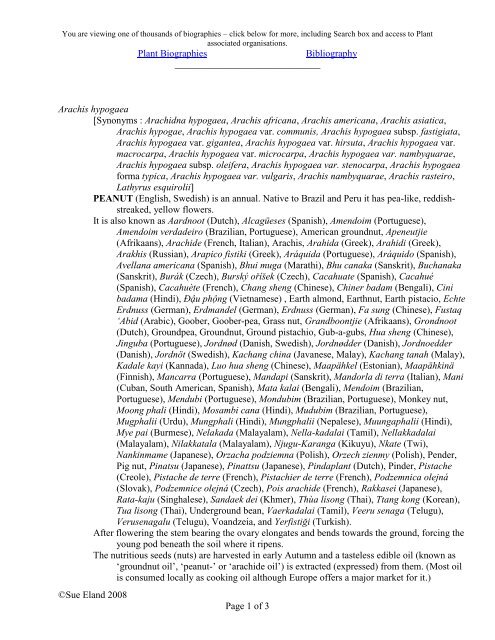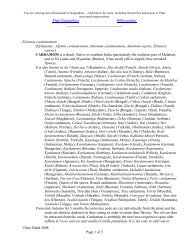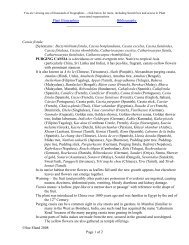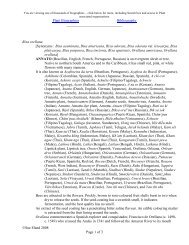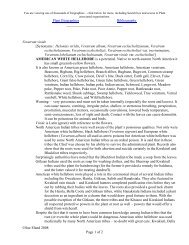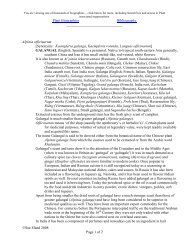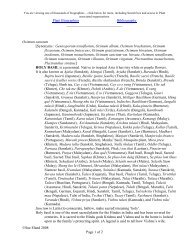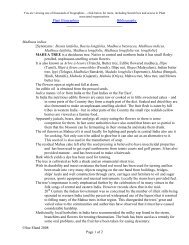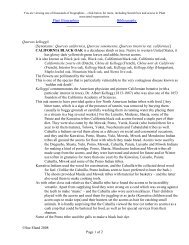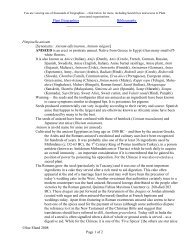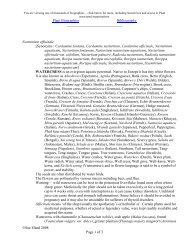You are viewing one of thousands of ... - Plant Biographies
You are viewing one of thousands of ... - Plant Biographies
You are viewing one of thousands of ... - Plant Biographies
Create successful ePaper yourself
Turn your PDF publications into a flip-book with our unique Google optimized e-Paper software.
<strong>You</strong> <strong>are</strong> <strong>viewing</strong> <strong>one</strong> <strong>of</strong> <strong>thousands</strong> <strong>of</strong> biographies – click below for more, including Search box and access to <strong>Plant</strong><br />
associated organisations.<br />
<strong>Plant</strong> <strong>Biographies</strong> Bibliography<br />
______________________________<br />
Arachis hypogaea<br />
[Synonyms : Arachidna hypogaea, Arachis africana, Arachis americana, Arachis asiatica,<br />
Arachis hypogae, Arachis hypogaea var. communis, Arachis hypogaea subsp. fastigiata,<br />
Arachis hypogaea var. gigantea, Arachis hypogaea var. hirsuta, Arachis hypogaea var.<br />
macrocarpa, Arachis hypogaea var. microcarpa, Arachis hypogaea var. nambyquarae,<br />
Arachis hypogaea subsp. oleifera, Arachis hypogaea var. stenocarpa, Arachis hypogaea<br />
forma typica, Arachis hypogaea var. vulgaris, Arachis nambyquarae, Arachis rasteiro,<br />
Lathyrus esquirolii]<br />
PEANUT (English, Swedish) is an annual. Native to Brazil and Peru it has pea-like, reddishstreaked,<br />
yellow flowers.<br />
It is also known as Aardnoot (Dutch), Alcagüeses (Spanish), Amendoim (Portuguese),<br />
Amendoim verdadeiro (Brazilian, Portuguese), American groundnut, Apeneutjie<br />
(Afrikaans), Arachide (French, Italian), Arachis, Arahida (Greek), Arahidi (Greek),<br />
Arakhis (Russian), Arapico fistiki (Greek), Aráquida (Portuguese), Aráquido (Spanish),<br />
Avellana americana (Spanish), Bhui muga (Marathi), Bhu canaka (Sanskrit), Buchanaka<br />
(Sanskrit), Burák (Czech), Burský oříšek (Czech), Cacahuate (Spanish), Cacahué<br />
(Spanish), Cacahuète (French), Chang sheng (Chinese), Chiner badam (Bengali), Cini<br />
badama (Hindi), Ðậu phộng (Vietnamese) , Earth almond, Earthnut, Earth pistacio, Echte<br />
Erdnuss (German), Erdmandel (German), Erdnuss (German), Fa sung (Chinese), Fustaq<br />
‘Abid (Arabic), Goober, Goober-pea, Grass nut, Grandboontjie (Afrikaans), Grondnoot<br />
(Dutch), Groundpea, Groundnut, Ground pistachio, Gub-a-gubs, Hua sheng (Chinese),<br />
Jinguba (Portuguese), Jordnød (Danish, Swedish), Jordnødder (Danish), Jordnoedder<br />
(Danish), Jordnöt (Swedish), Kachang china (Javanese, Malay), Kachang tanah (Malay),<br />
Kadale kayi (Kannada), Luo hua sheng (Chinese), Maapähkel (Estonian), Maapähkinä<br />
(Finnish), Mancarra (Portuguese), Mandapi (Sanskrit), Mandorla di terra (Italian), Mani<br />
(Cuban, South American, Spanish), Mata kalai (Bengali), Mendoim (Brazilian,<br />
Portuguese), Mendubi (Portuguese), Mondubim (Brazilian, Portuguese), Monkey nut,<br />
Moong phali (Hindi), Mosambi cana (Hindi), Mudubim (Brazilian, Portuguese),<br />
Mugphalii (Urdu), Mungphali (Hindi), Mungphalii (Nepalese), Muungaphalii (Hindi),<br />
Mye pai (Burmese), Nelakada (Malayalam), Nella-kadalai (Tamil), Nellakkadalai<br />
(Malayalam), Nilakkatala (Malayalam), Njugu-Karanga (Kikuyu), Nkate (Twi),<br />
Nankinmame (Japanese), Orzacha podziemna (Polish), Orzech zienmy (Polish), Pender,<br />
Pig nut, Pinatsu (Japanese), Pinattsu (Japanese), Pindaplant (Dutch), Pinder, Pistache<br />
(Creole), Pistache de terre (French), Pistachier de terre (French), Podzemnica olejná<br />
(Slovak), Podzemnice olejná (Czech), Pois arachide (French), Rakkasei (Japanese),<br />
Rata-kaju (Singhalese), Sandaek dei (Khmer), Thùa lísong (Thai), Ttang kong (Korean),<br />
Tua lisong (Thai), Underground bean, Vaerkadalai (Tamil), Veeru senaga (Telugu),<br />
Verusenagalu (Telugu), Voandzeia, and Yerfistiği (Turkish).<br />
After flowering the stem bearing the ovary elongates and bends towards the ground, forcing the<br />
young pod beneath the soil where it ripens.<br />
The nutritious seeds (nuts) <strong>are</strong> harvested in early Autumn and a tasteless edible oil (known as<br />
‘groundnut oil’, ‘peanut-’ or ‘arachide oil’) is extracted (expressed) from them. (Most oil<br />
is consumed locally as cooking oil although Europe <strong>of</strong>fers a major market for it.)<br />
©Sue Eland 2008<br />
Page 1 <strong>of</strong> 3
Warning – the nuts themselves <strong>are</strong> not poisonous but they can cause poisoning if they have<br />
been infected by a fungus.<br />
Hypogaea means ‘subterranean, underground or developing underground’.<br />
Peanut remains have been found by archaeologists in ancient tombs in Peru and it is also<br />
depicted on Chimu pottery. (The Chimu civilization <strong>of</strong> north-western Peru was<br />
established in 1000 and conquered by the Incas in 1470.). <strong>Plant</strong> remains have also been<br />
found in excavations in Mexico dating back to the last centuries BC. First known written<br />
mention <strong>of</strong> the plant is ascribed to Oviedo y Valdes (1478-1557) the Spanish historian<br />
who lived in Haiti from 1513 to 1525, where he was Director <strong>of</strong> Mines for the Spanish.<br />
He reported that mani (a name still used in Cuba and South America) was widely grown<br />
and consumed by local American Indians.<br />
In the middle <strong>of</strong> the 16<br />
©Sue Eland 2008<br />
Page 2 <strong>of</strong> 3<br />
th Century Portuguese traders introduced the plant to Africa where it<br />
flourished during the colonial era – and it was from there that slaves carried it back to the<br />
Americas, particularly to the Caribbean and to Virginia on the North American mainland.<br />
(This was yet another experimental crop to be found eventually on the Virginian estates<br />
<strong>of</strong> the 3 rd President <strong>of</strong> the United States, Thomas Jefferson (1743-1826).) It is believed to<br />
have reached India not long after its introduction to western Africa and botanical<br />
historians suspect the plant made a pincer movement on eastern Asia in that it was<br />
introduced both from the West and from the East over the Pacific. (It would seem that<br />
there <strong>are</strong> few written records <strong>of</strong> the use <strong>of</strong> the plant among North American Indian tribes<br />
but information that does exist indicates that the Seminole Indians ate the plant and the<br />
Huron tribe <strong>are</strong> believed to have consumed the roots as emergency rations.)<br />
Then in 1840 it was suggested by a French colonist <strong>of</strong> Cape Verde (<strong>of</strong>f the west African coast),<br />
a Monsieur Jaubert, that the peanut should be imported into Marseilles for the seed oil.<br />
App<strong>are</strong>ntly French spinners were having difficulties in getting sufficient supplies <strong>of</strong> olive<br />
oil at that time and peanut’s seed oil was viewed as a viable alternative. Initially the seeds<br />
were obtained from western Africa but once the Suez Canal had been opened in 1869<br />
more sources <strong>of</strong> supply were accessible, not least from India. This led eventually to<br />
today’s European market for groundnut oil (Olea europaea) used particularly for both<br />
culinary purposes and making soap.<br />
It was the American, John Harvey Kellogg (1852-1943) who, before joining his brother in the<br />
venture that led to the formation <strong>of</strong> the commercial food giant W K Kellogg Company in<br />
1906, developed the first peanut butter. In the 1870s (with some other foods) he devised<br />
this butter for his patients while he was physician in charge at the Western Health Reform<br />
Institute. Roughly a quarter <strong>of</strong> a century later another American, George Washington<br />
Carver (c.1860-1943) a celebrated botanist and scientist, was discovering an alleged 300<br />
uses for peanuts – and was encouraging its growth (and that <strong>of</strong> sweet potatoes, Ipomoea<br />
batatus) particularly among poor black farmers in the depleted soil left from the old<br />
cotton plantations in the Deep South. As at the European ‘Lupin banquet’ (Lupinus albus)<br />
in Hamburg in 1917, peanut was the basis <strong>of</strong> a promotional meal given by George Carver<br />
to some Alabama businessmen. The menu included peanut soup, peanut ‘chicken’ served<br />
with peanut prep<strong>are</strong>d as a vegetable and accompanied by peanut bread (made with peanut<br />
flour), followed by a salad with groundnut oil dressing. Then the pudding was peanut ice<br />
cream, complemented with peanut cookies – and finally c<strong>of</strong>fee (made from ground<br />
peanuts) accompanied by peanut candy.<br />
During World Wars I and II demand for the seed oil was greatly increased and experience <strong>of</strong><br />
this may well have been a contributory factor in the disastrous British decision to<br />
cultivate peanuts in Africa on a grand scale. The infamous ‘Groundnut Scheme’ is still<br />
remembered in Britain today. In 1946 the then British Government began a project for oil<br />
production in East Africa without giving adequate prior consideration to the ramifications
<strong>of</strong> such an exercise. It involved planting peanuts there over an <strong>are</strong>a <strong>of</strong> about 3 million<br />
acres. Over 100 million dollars were sunk in this Scheme but by 1951 (five years later)<br />
only 65,000 <strong>of</strong> the projected 3 million acres had been established. (Even this had actually<br />
been an achievement in the face <strong>of</strong> unreliable rainfall, the need for extensive land<br />
clearance, and disease.) It is hardly surprising that the Project had to be aband<strong>one</strong>d in a<br />
fog <strong>of</strong> scandal.<br />
Today in South America (peanut’s native habitat) and China, India and Africa the nuts continue<br />
to be harvested as an important world food crop. In Java (now an Ind<strong>one</strong>sian island) stem<br />
tips and young pods <strong>are</strong> boiled or roasted and eaten like a leaf vegetable, the seed cake<br />
left from oil pressings has been eaten in the past with rice (Oryza), and fried fermented<br />
seed paste has also provided a food. Malaysians eat the seeds not only with curries but<br />
also roasted and sugarcoated. The seed oil has been used to make a milk substitute. In<br />
North America and Europe peanut butter is a favourite spread (especially with children)<br />
and in the recent past in Europe the seeds have also <strong>of</strong>fered a c<strong>of</strong>fee substitute.<br />
The plant is grown as a forage crop too, and the foliage has been used as fodder and hay.<br />
Peanut, with sugar cane (Saccharum <strong>of</strong>ficinarum), tangerines (Citrus reticulata) and yam bean<br />
(Pachyrhizus erosus), plays a significant role in the Mexican Festival <strong>of</strong> the Dead which<br />
takes place annually on 1 st November.<br />
A very young saying, said to have started only in 1966<br />
If you pay peanuts, you get monkeys.<br />
means you get what you pay for.<br />
The oil is used today by the food industry (for canning, and the manufacture <strong>of</strong> margarine,<br />
peanut butter and salad oil) and in pharmaceutical preparations. Peanut flour is <strong>of</strong>ten an<br />
ingredient in commercially prep<strong>are</strong>d diabetic foods. The toiletry industry uses the oil in<br />
the manufacture <strong>of</strong> soap, creams and bath oils. It is also used in the manufacture <strong>of</strong><br />
plastics and lubricants. Oilcake provides animal feed, while the shells <strong>are</strong> used in<br />
insulation materials.<br />
Medicinally, in India the unripe nuts have been taken by nursing mothers to increase the flow<br />
<strong>of</strong> milk.. The oil has been used internally in remedies for some venereal diseases and it<br />
has been applied externally in treatments for rheumatism.<br />
©Sue Eland 2008<br />
Page 3 <strong>of</strong> 3


